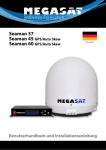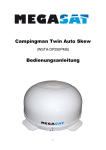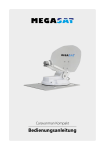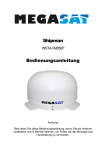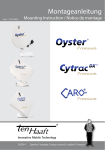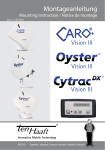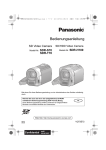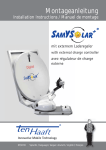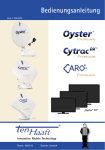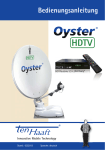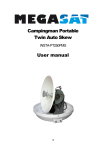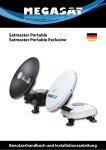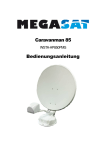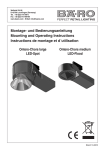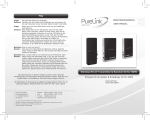Download Bedienungsanleitung
Transcript
Brillantes Fernsehen Shipman Shipman GPS/Auto Skew Deutsch Benutzerhandbuch und Installationsanleitung Inhaltsverzeichnis Sicherheitshinweise Vorsicht - Unsachgemäße Handhabung kann zu schweren Schäden an diesem Gerät führen. Diese Person kann auch für daraus resultierende weitere Schäden am Gerät verantwortlich gemacht werden. 1. Einführung Sicherheitshinweise.............................................................. 03 Kurzbeschreibung.................................................................. 03 Lieferumfang............................................................................. 03 Systemkomponenten.......................................................... 04 2. Installation Installation.................................................................................. 05 Klebeanleitung........................................................................ 06 Anschluss..................................................................................... 07 Das Steuergerät....................................................................... 08 Satellitenübertragung......................................................... 09 Inbetriebnahme und Bedienung................................. 10 Einstellen des LNB Skew.................................................... 11 3. Fehlerbehebung.................................................................... 12 4. Skew Einstellwerte............................................................... 13 5. Firmware Update................................................................... 14 6. Ausleuchtzone......................................................................... 16 7. Technische Daten.................................................................. 17 Hinweis – Lesen Sie das Benutzerhandbuch sorgfältig durch bevor Sie mit der Installation beginnen. Falls Sie schon ähnliche Produkte installiert haben, muss die Vorgehensweise mit diesem Produkt nicht übereinstimmen. Achtung – Die Antenne ist nicht für den Einsatz auf Salzgewässer geeignet, da es zu Korrosion an den Bauteilen der Antenne führen kann. Die Nutzung in direkter Nähe von Salzgewässern führt zum Verlust der Gewährleistung. Kurzbeschreibung Dieses Gerät ist eine der innovativsten und technologisch fortschrittlichsten SatellitenPositionierungs-Anlagen. Die Antenne verfügt über eine einzigartige Kombination von modernsten Komponenten. Vollen Komfort bietet die schnelle Satellitensuche und eine Kompatibilität mit allen digitalen, HD-fähigen Satelliten Receivern und TV Geräten. Lieferumfang Shipman / Shipman GPS/AS • Steuergerät (IDU) inkl. Stromkabel • 1x Antennenanschlusskabel (10 m) • 1x Antennenanschlusskabel (1 m) • Montagekleber (optional) • Netzteil 230 V (12 V, 5 A) (optional) • Bedienungsanleitung Megasat Werke GmbH | Industriestraße 4a | D-97618 Niederlauer | www.megasat.tv | [email protected] 02 DEUTSCH DEUTSCH 03 Systemkomponenten Installation Öffnen Sie die Box und entnehmen Sie das Steuergerät, die Anschlusskabel und das Verpackungsmaterial. Heben Sie die Antenne gerade nach oben aus der Verpackung. Stellen Sie die Anlage niemals auf den Kopf! Grundsätzlich empfehlen wir, den Einbau durch Ihren Fachhändler oder eine Fachwerkstatt vornehmen zu lassen! Achtung: Transportsicherung Entfernen Sie anschließend die mit „LOCK“ markierte Schraube auf der Unterseite der Antenne. Antenneneinheit Die elegante Kunstoffhaube schütz die Antenne bestens gegen äußere Witterungseinflüsse. Darunter befindet sich eine 45 cm Hochleistungsantenne. Die neue Elevationstechnik von 15-62° ermöglicht bestmöglichen Empfang in ganz Europa. Steuergerät (IDU) Das Steuergerät dient zur Satellitenauswahl und Steuerung. Es wird zwischen Antenne und Receiver geschaltet und versorgt die Antenne mit Strom. Achtung: Der Shipman GPS/AutoSkew besitzt zusätzlich eine Auto Skew Funktion, die den Polarisationswinkel des LNBs automatisch einstellt und einen GPS Empfänger für eine exakte und schnelle Positionsbestimmung. 04 DEUTSCH Achtung: Beachten Sie bitte auch, dass sich durch die Antenne die Fahrzeughöhe entsprechend ändert! Bitte halten Sie sich unbedingt an die einzelnen Punkte der Montageanweisung! Allgemeines: Sorgen Sie für einen geeigneten Arbeitsplatz, eine Garage/Halle ist besser als ein Platz im Freien. Die Umgebungstemperatur zur Montage soll zwischen +5° C und max. +25° C liegen. Arbeiten Sie nicht direkt in der Sonne. Halten Sie die Arbeitsvorschriften beim Umgang mit Chemieprodukten ein. Sorgen Sie für die notwendige Arbeitshygiene. Vorbereitung: 1.Vergewissern Sie sich, dass das Dach Ihres Fahrzeugs ausreichend stabil ist. Bei ungenügender oder zweifelhafter Dachstabilität ist ein ca. 2 mm starkes Blech mit ca. 100 x 100 cm auf der Dachaußenhaut zu befestigen. Erkundigen Sie sich dazu bei Ihrem Fahrzeughersteller. 2.Prüfen Sie, ob alle Teile vorhanden sind. Möglicherweise benötigen Sie zusätzlich eine Dachdurchführung für das Anschlusskabel der Antenne. Dieses erhalten Sie im Fachhandel. 3.Setzen Sie die Antenne auf den späteren Montageplatz und richten Sie sie so aus, dass der Antennenanschluss nicht in Fahrtrichtung zeigt. Achten Sie darauf, dass der Einbauplatz eben ist und keine Dachaufbauten im Weg sind, die den Satellitenempfang stören können. Aufbauten bis zu 8 cm Höhe spielen keine Rolle, höhere Aufbauten sollten einen entsprechenden Abstand zur Antenne haben, damit kein Hindernis zwischen Antenne und Satellit vorhanden ist . Der mindeste Abstand zu einer Klimaanlage sollte 30 cm betragen. 4.Säubern Sie die Montagefläche mit einem geeigneten Reiniger und einem Vliestuch um Schmutz und Unreinheiten zu entfernen. Zeichnen Sie anschließend die Antennenfüße mit einem Stift an. DEUTSCH 05 5.Rauen Sie die gezeichneten Flächen und Füße mit Schleifpapier (120er Körnung) leicht an und säubern Sie die Fläche erneut mit dem Reiniger (ACHTUNG: Flächen anschließend nicht mehr berühren) und lassen Sie den Reinigen ca. 10 Minuten ablüften. 6.Sofern Sie keine Möglichkeit haben, das Kabel durch eine vorhandene Dachdurchführung zu verlegen, suchen Sie eine geeignete Stelle (am besten im Windschatten hinter der Antenne) auf dem Fahrzeugdach für die Montage einer Dachdurchführung, um das Eindringen von Feuchtigkeit (z.B. Regen oder Spritzwasser) im Bohrloch zu vermeiden. Achten Sie darauf, dass die Kabel nicht zu sehr gebogen werden um Signalverlust und eine Beschädigung des Kabels zu vermeiden (kleinster Biegeradius max. 5-7 cm). Anschluss Montieren Sie das Steuergerät und den Satelliten Receiver im Fahrzeuginneren nicht im Bereich eines Airbags. Achten Sie auf eine sorgfältige Verlegung der Kabel, um Kurzschlüsse zu vermeiden. Achten Sie hierbei auch auf schon vorhandene Kabel. Schließen Sie die Antenne wie auf der Abbildung dargestellt an: Klebeanleitung Shipman 1.Bereiten Sie den Kleber für die Montage vor. oder mit dem optionalen Netzteil 230 V AC / 12 V DC 5A Receiver 3.Setzen Sie nun sofort (innerhalb von 5 Minuten nach Kleberauftrag) die Antenne auf die angezeichneten Felder. Drücken Sie die Füße leicht und gleichmäßig an und fixieren Sie die Antenne damit sie nicht verrutscht, z.B. durch ein Klebeband. Es müssen sich nach dem Andrücken noch mindestens 2 mm Kleber zwischen Antennenfuß und Oberfläche befinden. Der Kleber ist nach max. 48 Stunden bei +18° C und einer relativen Luftfeuchte von 50% ausgehärtet. Sollte während der Montagezeit eine geringe Luftfeuchtigkeit herrschen, sprühen Sie nach dem Verkleben in der Umgebung der Antenne immer wieder etwas Wasser in die Luft. 12~24 V DC 5 A Antenna 2.Tragen Sie nun den Kleber auf die Unterseite der Antennenfüße in Schlangenlinien auf, damit der Kleber bis ins Innere gut aushärten kann. Receiver Fernseher (+) ( - ) 4.Entfernen Sie die evtl. ausgetretene Klebemasse sofort mit einer Spachtel o. ä. und säubern Sie die verunreinigten Flächen mit dem Reiniger und einem Vliestuch. 5.Zur Sicherheit können Sie die Antennenfüße zusätzlich befestigen. Dazu bohren Sie durch das vorhandene Loch im jeweiligen Antennenfuß in das Dach Ihres Fahrzeuges und fixieren es durch eine Schraube mit Kontermutter. Damit die frisch verklebten Füße nicht verrutschen, warten Sie mit dieser Arbeit bis der Kleber ausgehärtet ist. 6.Nach der kompletten Montage und Aushärtung des Klebers, kann eine Silikonfuge um die Antennenfüße gezogen werden. 06 DEUTSCH DEUTSCH 07 Das Steuergerät Satellitenübertragung Vorderansicht des Steuergerätes LCD Display Satellitenauswahl (hoch/runter) ON SATELLITE SELECT OFF POWER Direct Broadcast Service (DBS) strahlt Audio, Video und Daten über den Satelliten aus, der sich in 35 km Höhe über der Erde befindet. Mit einer Empfangsstation wie die Antenne und einem Satelliten Receiver werden die Signale vom Satelliten empfangen und verarbeitet. Das System erfordert eine klare Sicht auf den Satelliten, um den Signalempfang maximal auszunutzen. Gutes Empfangssignal Schlechtes Empfangssignal SLEEP Abschaltung der Trackingfunktion Rückansicht des Steuergerätes SD Karten Einschub Anschluss Service SD CARD RS-232 Anschluss Anschluss Eingang Ausgang Receiver Antenne Stromver- Stromversorgung sorgung RECEIVER ANTENNA Objekte wie Bäume, Brücken und große Häuser, die sich im Einfallswinkel des Satelliten befinden, führen zu einem Verlust des Signals. Starker Regen, Wolken, Schnee oder Eis kann die Empfangsqualität beeinträchtigen. Wenn das Satellitensignal durch schwere Wetterbedingungen verloren geht, wird das laufende Programm des Receivers beendet (das Bild wird einfrieren, bzw. verschwinden). Wenn die Witterungsverhältnisse wieder einen guten Empfang ermöglichen, wird das TV Bild wieder hergestellt. IN OUT DC 12~24 V Achtung: Schließen Sie das Gerät immer über eine mit 7 Ampere abgesicherte, und mind. 2,5 mm² starke Leitung an (niemals direkt an die Auto Batterie). 08 DEUTSCH DEUTSCH 09 Inbetriebnahme und Bedienung 1.Schalten Sie den Fernseher und den Satelliten Receiver ein. Achten Sie darauf, dass die LNB Versorgungsspannung im Receiver eingeschaltet ist. 2.Schalten Sie das Steuergerät ein. Dieses überprüft die Kommunikation mit der Außeneinheit (Antenne) und zeigt im Display den voreingestellten Satelliten. Der Satellit kann mit den Satellitenauswahl-Tasten beliebig geändert werden. Anschließend startet der Suchvorgang. 3.Wenn ein Satellit gefunden wurde, stoppt die Antenne und führt eine Feinabstimmung durch. Danach beginnt die Identifizierung der Satellitenkennung (ID). Dieser Vorgang kann im Display verfolgt werden. Nach erfolgreicher Identifizierung erscheint „LOCKED“ im Display. Sollte der identifizierte Satellit nicht der von Ihnen gewählte sein, korrigiert die Antenne die Position. Sobald der richtige Satellit gefunden wurde, wird dieses im Display durch die Anzeige (z.B. ID:AS1) bestätigt. Nach erfolgreicher Suche ist der Empfang seitens der Antenne sichergestellt. 4.Der Shipman besitzt eine Tracking-Funktion (nachführendes System), die es ermöglicht, auch während der Fahrt ein permanentes Signal zu empfangen. Dieses geschieht vollautomatisch und bedarf keinerlei Einstellungen an den Geräten. Einstellen des LNB Skew Folgende Einstellungen sind nur für den Shipman (ohne Auto Skew). Eine Übersicht der Skew Einstellwerte finden Sie auf Seite 13. 0° -90° +90° Signale in vertikaler (rot) und horizontaler (blau) Linie haben einen Versatz von genau 90º zueinander. Durch die unterschiedliche Position der Satelliten, abhängig von Ihrem Standort, ist es möglich, dass die Signale nicht genau vertikal und horizontal auf das LNB treffen. Um dieses anzupassen, müssen Sie das LNB in die richtige Lage zu dem ausgesendeten Signal bringen. Diese Anpassung am LNB wird als „Skew Einstellung“ bezeichnet. Die folgende Abbildung zeigt Ihnen die optimale Einstellung des LNBs. Je genauer die Übereinstimmung, desto besser der Empfang. 5.Die Antenne ist ständig in Bewegung um evtl. Positionsänderungen sofort zu erkennen. Sollten Sie sich mit Ihrem Fahrzeug an einem festen Standort befinden, kann die Bewegung der Antenne störende Geräusche verursachen. Drücken Sie daher die „SLEEP“ Taste am Steuergerät, um die Tracking-Funktion der Antenne abzuschalten. Um die automatische Positionierung wieder zu aktivieren, starten Sie das Steuergerät bitte neu. 6.Wenn die Tracking-Funktion nicht deaktiviert wurde und es für mind. 10 min. keine Bewegung am Fahrzeug gab, schaltet die Antenne die Funktion automatisch ab. Sollte die Antenne, bzw. das Fahrzeug leicht bewegt werden (z.B. Laufen im Fahrzeug), wird die Tracking-Funktion automatisch wieder aktiviert. Hinweis: Ein Wechsel des Satelliten ist mit den Satellitenauswahl-Tasten jederzeit möglich. schlechter Empfang guter Empfang bester Empfang LNB Position Voreingestellte Satelliten: ASTRA 2 ASTRA 3 ASTRA 1 HOTBIRD 10 Position für Astra 2 auf 28,2° Ost Position für Astra 3 auf 23,5° Ost Position für Astra 1 auf 19,2° Ost Position für Hotbird auf 13° Ost ASTRA 4 THOR HISPASAT TURKSAT DEUTSCH Position für Astra 4 (Sirius) auf 4,8° Ost Position für Thor auf 0,8° West Position für Hispasat auf 30° West Position für Türksat auf 42° Ost Satellitensignal DEUTSCH 11 Fehlerbehebung Skew Einstellwerte Kein Satellitensignal • Objekte wie Bäume, Brücken und große Häuser, die sich im Einfallswinkel des Satelliten befinden, führen zu einem Verlust des Signals. • Wenn das Satellitensignal durch schwere Wetterbedingungen verloren geht, wird das laufende Programm des Receivers beendet (das Bild wird einfrieren, bzw. verschwinden). Wenn die Witterungsverhältnisse wieder einen guten Empfang ermöglichen, wird das TV Bild wieder hergestellt. • Vergewissern Sie sich, dass in den Einstellungen des Receivers die LNB Spannung eingeschalten ist. • Nur bei Shipman (ohne AutoSkew) Sollte die Antenne keinen Satelliten finden, überprüfen Sie die Skeweinstellung des Satelliten für ihren Standort. Eine Übersicht der Skew Einstellwerte finden Sie auf Seite 13. Die Grundeinstellung des LNBs ist 0 Grad. Sollte diese laut Liste mehr als 5 Grad abweichen, korrigieren Sie die Gradzahl entsprechend. Gibt es Verschmutzung auf der Antenne? Starke Verschmutzung auf dem Gehäuse kann zu Empfangsproblemen führen. Ist alles richtig angeschlossen und eingeschaltet? Vergewissern Sie sich, dass der TV und der Receiver richtig angeschlossen und der Receiver für den Satellitenempfang richtig eingestellt ist. Sind alle Kabel richtig angeschlossen oder hat die Verbindungen eine andere Person versehentlich gelockert? Satelliten Ausleuchtzone Satelliten sind in festen Positionen über dem Äquator im Orbit positioniert. Um die TV Signale zu empfangen, muss der Empfangsort innerhalb der Ausleuchtzone liegen. Mit der Abbildung auf Seite 14 können Sie überprüfen, ob sich Ihr Standort in der Ausleuchtzone des Satelliten befindet. In den Randgebieten der Ausleuchtzone kann es zu Empfangsstörungen kommen. Satellitenfrequenz wurde geändert Fernsehsender wechseln vereinzelt Ihre Frequenz die mit der Frequenz im Receiver dann nicht mehr übereinstimmt. Erkundigen Sie sich nach der aktuellen Frequenz des Senders. Fehlermeldung im Display: „Communication Error“ Die Antenne hat keine Verbindung zum Steuergerät. Überprüfen sie die Verkabelung zur Antenne. 12 DEUTSCH DEUTSCH 13 Firmware Update Updatevorgang: Wenn die Frequenz, auf der die Antenne den Satelliten idendifiziert, abgeschaltet wird, muss ein Firmwareupdate des Steuergerätes durchgeführt werden. 1.Schalten Sie das Steuergerät aus. Die aktuelle Firmware Version des Steuergerätes können Sie in den ersten 3 Sekunden nach dem Einschalten im unteren Bereich des Displays ablesen. 3.Schalten Sie das Steuergerät ein. Folgendes erscheint im Display: Bitte erkundigen Sie sich auf unserer Homepage nach der aktuellsten Firmware Version. Vorbereitung der SD Karte: 2.Stecken Sie die SD Karte in den Slot auf der Rückseite des Steuergerätes. SD CARD DETECTED WRITING SOFTWARE 4.Nachdem die Software kopiert wurde, erscheint folgende Meldung: SD CARD LOAD COMPLETE 5.Schalten Sie nun das Steuergerät aus und entfernen Sie die SD Karte. Bevor Sie die SD Karte benutzen, formatieren Sie sie auf “FAT32“ 6.Schalten Sie das Steuergerät wieder ein. Die Firmware ist nun aktualisiert. Nachdem Sie die SD Karte formatiert haben, kopieren Sie die neue Software darauf. 14 DEUTSCH DEUTSCH 15 Ausleuchtzone Technische Daten Antennen Typ.....................................Off-Set-Spiegel Anzahl der Teilnehmer..................1 LNB Typ...................................................Universal LNB Frequenzband ...................................Ku Band Frequenzbereich ..............................10.7 GHz bis 12.75 GHz LNB Verstärkung................................33 dBi Empfangsleistung............................49 dBW Polarisation...........................................V/H oder RHCP/LHCP Motorsteuerung................................2-Achsen DC Motor Neigungswinkel................................15° bis 62° Suchwinkel...........................................360° Drehgeschwindigkeit....................50° pro Sekunde Ausrichtungszeit...............................1 - 2 min. Temperaturbereich..........................-25° C bis +70° C Spannungsversorgung.................12 V DC @ 5 Ampere Gewicht..................................................9 kg (Shipman) / 12 kg (Shipman GPS/AS) Abmessungen Spiegel..................450 x 300 mm (B/H) Abmessungen Antenne...............700 x 400 mm (Ø/H) Abmessungen Steuergerät........245 x 43 x 147 mm (B/H/T) Konformitätserklärung Hinweis: In den Randgebieten der Ausleuchtzone kann es zu Empfangsstörungen kommen. Hinweis: Gewicht und Abmessungen sind nicht die absolut exakten Werte. Technische Details können jederzeit geändert werden (nach Hersteller) ohne vorherige Ankündigung. Konformitätserklärung Hiermit wird die Übereinstimmung mit folgenden Richtlinien/Normen bestätigt: Richtlinie zur elektromagnetischen Verträglichkeit 2004/108/EG EN 55013: 2001 + A1: 2003 + A2: 2006 EN 55020: 2007 EN 61000-3-2:2006 + A1:2009 + A2:2009 EN 61000-3-3:2008 Niederspannungsrichtlinie 2006/95/EG EN 60065: 2002 + A1: 2006 + A11: 2008 16 DEUTSCH DEUTSCH 17 Brillantes Fernsehen Shipman Shipman GPS/Auto Skew English Stand: v2.0 April 2013 User manual and installation instructions Contents Safety Information Caution – Improper handling by unqualified personnel can cause serious damage to this equipment. Unqualified personnel who tamper with this equipment may be held liable for any resultant damage to the equipment. 1. Introduction Safety Information................................................................. 03 Short description.................................................................... 03 Delivery......................................................................................... 03 System Components........................................................... 04 2. Installation Installation.................................................................................. 05 Gluing instructions................................................................ 06 Connection................................................................................ 07 The control unit....................................................................... 08 Satellite broadcasting.......................................................... 09 Startup and operation......................................................... 10 Setting the LNB skew........................................................... 11 3. Troubleshooting.................................................................... 12 4. Skew Settings........................................................................... 13 5. Firmware Update................................................................... 14 6. Footprint...................................................................................... 16 7. Specifications........................................................................... 17 02 ENGLISH Note – Before you begin, carefully read each of the procedures in this manual. If you have not performed similar operations on comparable equipment, do not attempt to perform these procedures. Short description The satellite antenna system is the innovative and a technologically advanced satellite Positioner system. The antenna has a unique combination of cutting-edge components. Fast satellite search and compatibility with all digital, HD-ready set-top boxes and TV sets are guaranteed. Delivery Shipman / Shipmas GPS/AS • Control unit (IDU) incl. powercable • 1x antenna cable (10 m) • 1x antenna cable (1 m) • Installation glue (optional) • Power supply 230 V (12 V, 5 A) (optional) • User manual ENGLISH 03 System Components Installation Open box and remove the control unit, cables and packing material. Lift the antenna straight up out of the box. Never place the system upside down! Basically, we recommend that you leave the installation to make by your dealer or workshop! Warning: Please also note that the antenna height of the vehicle will change accordingly! Please strictly adhere to the various points in the installation instructions! Warning: transport lock Then remove with the „LOCK“ marked screw on the bottom of the antenna. Antenna unit The elegant plastic housing will protecting the antenna against outside weather conditions. Under the housing there is a 45 cm high-performance antenna. The new technology of 0-90 ° elevation enables optimal reception across Europe. Control unit (IDU) The control unit is used for satellite selection and control. It is connected between the antenna and the set-top box and supplied the antenna with electricity. General information: Provide a suitable working environment, a garage/warehouse is better than open air. The ambient temperature for installation is between +5° C and max. +25° C. Work not directly in the sun. Comply with the safety regulations when handling with chemical products. Provide the necessary hygiene. Preparation: 1.Make sure that the roof of your vehicle is sufficiently stable. In case of insufficient or doubtful roof stability is an approximately 2 mm thick plate with 100 x 100 cm is to be attached to the outer roof skin. Ask to your vehicle manufacturer. 2.Make sure that all parts are present. You may also need a roof penetration for the connecting cable of the antenna. This you get in specialist shops. 3.Place the antenna on the installation area and align it so that the antenna connection is not facing forward. Make sure that the mounting location is flat and do not interfere with roof constructions that can interfere with satellite reception. Constructions up to 8 cm in height do not matter, higher constructions should have a respective distance from the antenna, so that no barrier exists between the antenna and the satellite. The least distance to an air conditioner should be 30 cm. 4.Clean the mounting surface with a suitable cleaner and a fleece cloth to remove dirt and impurities. Then draw the antenna feet with a pen. Warning: The Campingman Twin/AutoSkew has an additional Auto Skew function that adjust the polarization angle of the LNB automatically, and a additional connection for a second set-top box. The control unit must be operated only on the selected antenna port. Only this is provided for controlling. 04 ENGLISH ENGLISH 05 1.Roughen the drawn areas and feet with sandpaper (120 grit) to easily and thoroughly clean the surface again with Cleaner (WARNING: then no longer touch areas) and let the clean dry for about 10 minutes. 2.Unless you have a way to run the cable through an existing roof outlet, look for a suitable place (best in the wind shadow behind the antenna) on the roof for the installation of a roof outlet to avoid the ingress of moisture (eg rain or splash water) in the wellbore. Make sure that the cables are not curved too much to avoid signal loss and damage the cable (bending radius max. 5-7 cm). Connection Install the control unit and the set-top box is not inside the vehicle in the region of an airbag. Maintain a careful installation of the cable in order to avoid short circuits. Pay attention also to existing cables. Connect the antenna as shown in the illustration below: Gluing instructions Shipman 1.Prepare the glue for mounting. or with the optional power supply 230 V AC / 12 V DC 5A Receiver 3.Now place immediately (within 5 minutes after adhesive application), the antenna on the marked fields. Press your feet slightly and evenly and fix the antenna so that it stays in place, eg by an adhesive tape. It must be after pressing for at least 2 mm glue between antenna and surface. The adhesive is cured max. in 48 hours at +18° C and a relative humidity of 50%. Should prevail low humidity during the assembly time, spray after bonding in the vicinity of the antenna always some water in the air. 12~24 V DC 5 A Antenna 2.Now take the glue on the underside of the antenna bases in serpentine lines, so that the glue can harden well to the inside. Receiver Television (+) ( - ) 4.Remove any spilled adhesive immediately with a putty knife or similar and clean the soiled surfaces with the cleaner and a fleece cloth. 5.For safety, you can attach the antenna bases additionally. Given by drill through the existing hole in the respective antenna to the roof of your car and fix it with a screw with locking nut. In order for the freshly bonded feet can not slip, wait with this work until the adhesive has cured. 6.After the complete assembly and curing of the adhesive, a silicone can be drawn around the antenna bases. 06 ENGLISH ENGLISH 07 Satellite broadcasting The contron unit Front view of the control unit LCD Display Satellite Select (up/down) ON SATELLITE SELECT OFF POWER Direct Broadcast Service (DBS) satellites broadcast audio, video and data information from satellites located 22 miles in space. A receiving station, such as the antenna, should include a dish and satellite receiver to receive the signals and process them for use by the consumer audio and video equipment. The system requires a clear view of the satellite to maximize the signal reception. good reception signal bad reception signal SLEEP Interrupt tracking Rear view of the control unit SD Card Slot connector service SD CARD RS-232 connector connector input set-top box antenna power supply RECEIVER ANTENNA output power supply Objects such as tall lighthouse, bridges and big ship that block this view will cause a loss of signal. The signal will be quickly restored once the antenna has a clear line of sight again. Heavy rain, cloud, snow or ice may also interfere with the signal reception quality. If the satellite signal is lost due to blockage or severe weather condition, services from the receiver will be lost (picture will freeze frame and may disappear). When the satellite signal strength is again high enough, then the receiver will resume providing desired programming services. IN OUT DC 12~24 V Warning: Connect the device only at a 7 amp protected line. The line must be at least 2.5 mm² strong. (never directly to the car battery). 08 ENGLISH ENGLISH 09 Startup and operation 1.Turn on the TV and the set-top box. The green LNB LED on the display of the control box lights up when the satellite receiver is turned on and a supply voltage for the LNB is available. Setting the LNB Skew The following settings are only for the Shipman (without AutoSkew). An overview of the skew settings can be found on page 13. 2.Turn on the control unit. Then, the indicator of the preset satellites lights red. Shortly thereafter, the LED starts to flash for about 5 seconds. Only this time you can select another satellite by press the white key. Each press of the button, the display will continue to a satellite position. Press it as long until the desired satellite is flashing. Now the search is started. 3.When a satellite is found, the antenna stop and carries out a fine-tuning. Then begins to identify the satellite identification (ID). This process can be tracked on the display. After successful identification „LOCKED“ appears in the display. Should not be identified the satellite of your choice, the antenna corrected the position. Once the satellite is correct, the display will show it (eg ID:AS1). After a successful search, the receiver is assured by the antenna. 4.The Shipman has a tracking function, which allows to receive even while driving a permanent signal. This is fully automatic and requires no adjustments to the equipment. 0° -90° +90° Signals in the vertical (red) and horizontal (blue) line have an offset of exactly 90° to each other. Due to the different position of the satellites, depending on your location, it is possible that the signals do not meet exactly vertically and horizontally on the LNB. To adjust this, turn the LNB into the correct position to the transmitted signal. This adjustment to the LNB is called „skew adjustment“. The following figure shows the optimal setting of the LNB. More accurate the match, the better of reception. 5.The antenna is constantly moving in order to detect any changes in the position. If your vehicle at a fixed location, the movement of the antenna cause irritating noises. Therefore press the „SLEEP“ button on the control unit to turn off the tracking function of the antenna. To activate the automatic positioning again, please restart the control unit. 6.When the tracking function is not disabled and there was no movement on the vehicle at least for 10 min., the function is switched off automatically. If the antenna or the vehicle moves easily (eg walking in the vehicle), the tracking function is activated automatically. Note: Changing the satellite is only possible shortly after switching on the power (as described in point 3) or after successful satellite search. Preprogrammed satellites: ASTRA 2 ASTRA 3 ASTRA 1 HOTBIRD 10 Position for Astra 2 to 28,2° East Position for Astra 3 to 23,5° East Position for Astra 1 to 19,2° East Position for Hotbird to 13° East ASTRA 4 THOR HISPASAT TURKSAT ENGLISH Position for Astra 4 (Sirius) to 4,8° East Position for Thor to 0,8° West Position for Hispasat to 30° West Position for Turksat to 42° East bad reception good reception best reception LNB position Satellite Signal ENGLISH 11 Troubleshooting Skew Settings No Signal • Objects such as trees, bridges, and large buildings, which are located in the angle of the satellite will lead to a loss of the signal. • If the satellite signal is lost through severe weather conditions, the current program of the receiver is stopped (the image freeze, or disappear). If the weather conditions allow a good reception again, the TV screen will be restored. • Make sure that the settings of the set-top box to LNB voltage is switched on. This is indicated by the green LED on the control unit (LED green = LNB voltage present). • Only Shipman (without AutoSkew) If the antenna has not found satellites, check the Skew settings for the satellite at your location. An overview of the skew settings can be found on page 13. The basic setting of the LNB is 0°. Should they deviate more than 5°, adjust the degrees accordingly. There is dirt on the antenna? Excessive dirt on the housing may cause reception problems. Everything is properly connected and turned on? Your satellite TV receiver might be set up incorrectly or defective. First check the receiver’s configuration to ensure it is set up for the desired programming. In the case of a faulty receiver, refer to your selected receiver’s user manual for service and warranty information. Satellite footprint Television satellites are located in fixed positions above the Earth’s equator and beam TV signals down to certain regions of the planet (not worldwide). To receive TV signals from a satellite, you must be located within that satellite’s unique coverage area. With the figure on page 10, you can check if you are located in the footprint of the satellite. In the outlying areas of the footprint there may be interference. Satellite Frequency Data Changed If some channels work, while one or more other channels do not, or if the antenna cannot find the selected satellite, the satellite’s frequency data might have changed. Error message on the display: „Communication Error“ The antenna is not connected to the control unit. Check the wiring to the antenna. 12 ENGLISH 11 ENGLISH 13 Firmware Update Update process: When the frequency is switched off, on which the antenna idendifiziert the satellite, you must update the firmware of the control unit. 1.Turn off the controller. The current firmware version of the control unit, you can read on the bottom of the screen in the first 3 seconds after switching on. 3.Turn on the control unit. The following will appear in the display: Please check our website for the latest firmware version. 2.Insert the SD card into the slot on the rear side of the control unit. SD CARD DETECTED WRITING SOFTWARE Preparing the SD card: 4.After the software is copied, the following message appears: SD LOAD COMPLETE CARD 5.Now switch off the control unit and remove the SD card. Before you use the SD card, format it to „FAT32“ 6.Turn on the control unit again. The firmware is updated now. After you format the SD card, copy the new software on it. 14 ENGLISH 11 ENGLISH 15 Footprint Specifications Antenna typ................................................Off-Set-Dish Users................................................................1 LNB typ...........................................................Universal LNB Frequenzy band ......................................Ku Band Frequenzy range .....................................10.7 GHz to 12.75 GHz LNB gain........................................................33 dBi Minimum EIRP...........................................49 dBW Polarization..................................................V/H or RHCP/LHCP Type of Stabilisation...............................2-Axis DC Motor Elevation.......................................................15° to 62° Azimuth.........................................................360° Tracking rate...............................................50° / sec. Alignment time........................................1 - 2 min. Temperature range.................................-25° C to +70° C Power supply..............................................12 V DC @ 5 Amps Weight............................................................9 kg (Shipman) / 12 kg (Shipman GPS/AS) Dimensions dish.......................................450 x 300 mm (B/H) Dimensions antenna.............................700 x 400 mm (Ø/H) Dimensions control unit.....................245 x 43 x 147 mm (B/H/T) Declaration of Conformity Note: In the outlying areas of the footprint there may be interference. Note: Weight and dimensions are not absolutely exact values. Technical details can be changed at any time (according to manufacturer) without prior notice. Declaration of Conformity This complies with the following directives / standards is confirmed: Electromagnetic Compatibility Directive 2004/108/EC EN 55013: 2001 + A1: 2003 + A2: 2006 EN 55020: 2007 EN 61000-3-2:2006 + A1:2009 + A2:2009 EN 61000-3-3:2008 Low Voltage Directive 2006/95/EG EN 60065: 2002 + A1: 2006 + A11: 2008 16 ENGLISH 11 ENGLISH 17 Status: v2.0 April 2013
This document in other languages
- Deutsch: Megasat Shipman



















